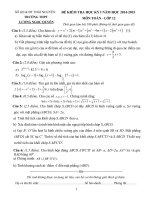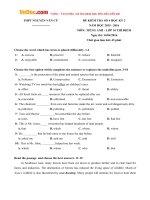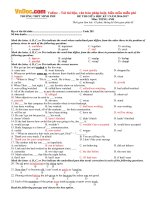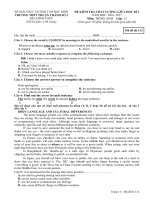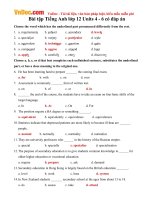Tải Đề thi học kì 1 lớp 12 môn tiếng Anh trường THPT Lương Văn Cù năm 2020 - Đề thi tiếng Anh 12 học kì 1 có đáp án
Bạn đang xem bản rút gọn của tài liệu. Xem và tải ngay bản đầy đủ của tài liệu tại đây (143.61 KB, 9 trang )
<span class='text_page_counter'>(1)</span><div class='page_container' data-page=1>
<b>Đ THI H C KÌ 1 L P 12</b>
<b>Ề</b>
<b>Ọ</b>
<b>Ớ</b>
<b> MƠN TIẾNG ANH</b>
<b>CĨ ĐÁP ÁN NĂM 2020 - 2021</b>
<i><b>Mark the letter A, B, C, or D on your answer sheet to indicate the underlined part that</b></i>
<i><b>needs correction in each of the following questions.</b></i>
<b>Question 1: For thousands of years, man (A) has created sweet-smelling (B) substances</b>
<b>from wood, herbs, and flowers and using them (C) for perfume or (D) medicine.</b>
<b>Question 2: Food prices have raised (A) so rapidly (B) in the past few months that (C)</b>
<b>some families have been forced to alter (D) their eating habits.</b>
<b>Question 3: The number of students (A) attending (B) universities to study economics </b>
<b>(C) have (D ) increased steadily in the last few years.</b>
<i><b>Mark the letter A,B,C or D on your answer sheet to indicate the sentence that is closest</b></i>
<i><b>in meaning to each of the following sentences. </b></i>
<b>Question 4: My mother started working as a teacher of Math when she was 22 years old.</b>
A. My mother has been working as a teacher of Math at the age of 22.
B. My mother has been working with a teacher of Math since the age of 22.
C. My mother has been working as a teacher of Math since she was 22 years old.
D. My mother has been working as a teacher of Math when she was 22 years old.
<b>Question 5: “What did you do last night?” the policeman asked the woman. </b>
A. The policeman asked the woman what did she do the night before.
B. The policeman asked the woman what she had done the night before.
C. The policeman asked the woman what had she done the night before.
D. The policeman asked the woman what she did the night before.
<b>Question 6: It’s a pity that you didn’t tell us about this.</b>
A. I wish you told us about this. B. I wish you would tell us about this
C. I wish you had told us about this D. I wish you have told us about this
<i><b>Mark the letter A,B,C or D on your answer sheet to indicate the sentence that best</b></i>
<i><b>combines each pair of sentences in the following sentences</b></i>
<b>Question 7: The children were playing football in the schoolyard. They were my </b>
students.
</div>
<span class='text_page_counter'>(2)</span><div class='page_container' data-page=2>
B. The children playing football in the schoolyard were my students.
C. The children who they were my students were playing in the schoolyard.
D. The children that they were my students were playing in the schoolyard.
<b>Question 8: His friends supported and encouraged him. He did really well in the </b>
competition.
A. If his friends had given him support and encouragement, he could have done really
well in the competition.
B. No matter how much his friends supported and encouraged him, he couldn't do
well in the competition.
C. Such were his friends' support and encouragement that he couldn't do really well
in the competition.
D. Without his friends' support and encouragement, he couldn't have done so well in
the competition.
<i><b>Read the following passage and mark the letter A, B, C, or D on your answer sheet to</b></i>
<i><b>indicate the correct answer to each of the questions</b></i>
Educating children at home as an alternative to formal education is an option chosen
by families in many parts of the world. The homeschooling movement is popular in the
United States, where close to one million children are educated at home. In Canada 1
percent of school-age children are homeschooled, and the idea also enjoys growing
popularity in Australia, where 20,000 families homeschool their children. The movement
is not limited to these countries. Homeschooling families can be found all over the
world, from Japan to Taiwan to Argentina to South Africa.
Homeschooling is not a novel idea. In fact, the idea of sending children to spend
most of their day away from home at a formal school is a relatively new custom. In the
United States, for example, it was not until the latter part of the nineteenth century that
<b>state governments began making school attendance compulsory. Before that, the concept</b>
<b>of a formal education was not so widespread. Children learned the skills they would</b>
need for adult life at home from tutors or their parents, through formal instruction or by
working side by side with the adults of the family.
</div>
<span class='text_page_counter'>(3)</span><div class='page_container' data-page=3>
their only option. Children who have exceptional talents in the arts or other areas may be
homeschooled so that they have more time to devote to their special interests. Much of
the homeschooling movement is made up of families who, for various reasons, are
dissatisfied with the schools available to them. They may have a differing educational
philosophy, they may be concerned about the safety of the school environment, or they
may feel that the local schools cannot adequately address their children's educational
needs. Although most families continue to choose a traditional classroom education for
their children, homeschooling as an alternative educational option is becoming more
popular.
<b>Question 9: Which of the following could be the main idea of the passage?</b>
A. The origin of homeschooling.
B. A new form of school: Homeschooling
C. Homeschooling option: a common form of education all over the world.
D. The reasons why children should be educated at home.
<b>Question 10: What does the word “that” in paragraph 2 refer to?</b>
A. the former part of the 19th century B. the end of the 19th century
C. the second half of the 19th century D. the beginning of the 19th century
<b>Question 11: The word "widespread" in paragraph 2 mostly means _________.</b>
A. uncommon B. customary C. exceptional D. prevalent
<b>Question 12: According to the passage, the following are true about the homeschooling,</b>
<b>EXCEPT _________.</b>
A. Many families in both developed and developing countries choose to educate their
children at home.
B. Parents or tutors were the ones who taught the children necessary skills in society.
C. People got familiar with school attendance before choosing to learn at home.
D. Before modern times, most students did not attend the school.
<b>Question 13: As mentioned in the last paragraph, children in rural areas _________.</b>
A. are not contented with the philosophy of the schools available.
B. believe that their needs to study is more than what a normal school can provide.
C. have no choice but stay at home to learn.
D. prefer to improve their extraordinary interests.
</div>
<span class='text_page_counter'>(4)</span><div class='page_container' data-page=4>
A. parents’ satisfaction plays an important role in the number of students attending
class.
B. teachers’ qualifications may be one of the reasons why students come to school.
C. not many children in modern society are allowed to be educated at home.
D. some schools are unable to provide a safe environment for their students.
<i><b>Question 15: What does the author mean in the sentence : Although most families</b></i>
<i>continue to choose a traditional classroom education for their children, homeschooling</i>
<i>as an alternative educational option is becoming more popular.?</i>
A. Families are gradually aware of the importance of school attendance.
B. More and more parents choose homeschooling to educate their children.
C. Homeschooling will replace the traditional classroom one day in the future.
D. Many people prefer formal schools because of its fame.
<i><b>Mark the letter A, B, C, or D on your answer sheet to indicate the most suitable</b></i>
<i><b>response to complete each of the following exchanges.</b></i>
<b>Question 16: Mr. George is having a date with Ms. Rose at his house.</b>
<b>- Mr. George: “That’s a very nice skirt you’re wearing.”</b>
- Ms. Rose: “_________”
A. Thank you for your compliment! B. That’s all right.
C. Yes, it will D. You are welcome.
<b>Question 17: Two friends are talking about the benefits of swimming .</b>
- Daisy: “As far as I know, swimming is a really helpful thing for everyone to
improve their health.”
- Mark: “_________.”
A. That sounds great. B. I couldn't agree with you
more.
C. Take part in this summer. D. That's fine for me.
<i><b>Mark the letter A,B,C, or D on your answer sheet to indicate the word that differs </b></i>
<i><b>from the other three in pronunciation in each of the following questions.</b></i>
<b>Question 18: A. broaden</b> B. enter C. travel D. absord
<b>Question 19: A. persistent </b> B. dynamic C. sensitive D. ambitious
</div>
<span class='text_page_counter'>(5)</span><div class='page_container' data-page=5>
Body language is a vital form of communication. In fact, it is believed that the
various forms of body language contribute about 70 percent to our comprehension. It is
important to note, however, that body language varies in different cultures. Take for
example, eye movement. In the USA a child is expected to look directly at a parent or
teacher who is scolding him/her. In other cultures the opposite is true. Looking directly
at a teacher or parent in such a situation is considered a sign of disrespect.
Another form of body language that is used differently, depending on the culture,
is distance. In North America people don't generally stand as close to each other as in
<b>South America. Two North Americans who don't know each other well will keep a</b>
distance of four feet between them, whereas South Americans in the same situation will
stand two to three feet apart. North Americans will stand closer than two feet apart only
<b>if they are having a confidential conversation or if there is intimacy between them.</b>
Gestures are often used to communicate. We point a finger, raise an eyebrow,
wave an arm – or move any other part of the body – to show what we want to say.
However, this does not mean that people all over the world use the same gestures to
express the same meanings. Very often we find that the same gestures can communicate
different meanings, depending on the country. An example of a gesture that could be
<b>misinterpreted is sticking out the tongue. In many cultures it is a sign of making a</b>
<b>mistake, but in some places it communicates ridicule.</b>
The dangers of misunderstanding one another are great. Obviously, it is not
enough to learn the language of another culture. You must also learn its non-verbal
signals if you want to communicate successfully.
<b>Question 20: What is the passage mainly about?</b>
A. Non-verbal communication across cultures
B. Misunderstandings in communication
C. Interpretations of gestures in different cultures
D. The significance of non-verbal signals in America
<b>Question 21: The word "misinterpreted" in paragraph 3 is closest in meaning to</b>
_________.
A. mispronounced B. misbehaved C. misspelled D. misunderstood
<b>Question 22: The word "it" in paragraph 3 refers to _________.</b>
</div>
<span class='text_page_counter'>(6)</span><div class='page_container' data-page=6>
C. sticking out the tongue D. making a mistake
<b>Question 23: As stated in the passage, in order to communicate successfully with people</b>
from another
culture, it is advisable for a person __________.
A. to use the body language of the people from that culture
B. to learn both the language and non-verbal signals of that culture
C. to learn only non-verbal signals of that culture
D. to travel to as many countries as possible
<b>Question 24: Which form of body language is NOT mentioned in the passage?</b>
A. distance B. posture C. gesture D. eye movement
<i><b>Mark the letter A, B, C, or D on your answer sheet to indicate the word whose</b></i>
<i><b>underlined part differs from the other three in pronunciation in each of the following</b></i>
<i><b>questions.</b></i>
<b>Question 25: A. moved</b> <b>B. enjoyed</b> <b>C. liked</b> <b>D. achieved</b>
<b>Question 26: A. fashion</b> <b>B. signal </b> <b>C. contact </b> <b>D. attract</b>
<i><b>Mark the letter A, B, C, or D on your answer sheet to indicate the word(s) CLOSEST</b></i>
<i><b>in meaning to the underlined word(s) in each of the following questions.</b></i>
<b>Question 27: When you hurt someone unintentionally, you should say “sorry” to him or</b>
her in any way.
A. advise B. persuade C. respect D. apologize
<b>Question 28: I’m sorry I can’t go to the movies with you this weekend - I’m up to my </b>
<b>ears in work.</b>
A. very busy B. very bored C. very scared D. very idle
<i><b>Mark the letter A, B, C, or D on your answer sheet to indicate the correct answer to</b></i>
<i><b>each of the following questions.</b></i>
<b>Question 29: She will take the management training course _________.</b>
A. right after the epidemic has been controlled
B. as soon as the epidemic was controlled
C. when the epidemic had been controlled
D. until the epidemic will be controlled
<b>Question 30: It is said the Robinhood robbed _________ rich and gave the money to the</b>
</div>
<span class='text_page_counter'>(7)</span><div class='page_container' data-page=7>
A. an B. a C. the D. no article
<b>Question 31: She’s expected to be accustomed _________living in the country.</b>
A. in B. to C. at D. for
<b>Question 32: The patients _________ with the new drug showed better signs of</b>
recovery than those receiving conventional medicine.
A. treated B. having treated C. treating D. who treated
<b>Question 33: Whistling or clapping hands to get someone’s attention is considered</b>
_________ and even rude in some circumstances.
A. suitable B. sociable C. appropriate D. impolite
<b>Question 34: Action movies may have a negative _________ on children. They tend to </b>
be more violent after watching action movies.
A. opinion B. influence C. dependence D. decision
<b>Question 35: I can't go with you because I ________my homework yet.</b>
A. hadn’t finished B. haven't finished C.didn’t finish D. don’t finish
<b>Question 36: Hoa hoped that she _________ to join the club. She could make friends</b>
with many people here.
A. invited B. invites C. would be invited D. was inviting
<b>Question 37: The government suggests_________robots to access remote areas that are</b>
dangerous to the lives of militants.
A. designing B. designed C. to design D. design
<b>Question 38: Although David was _________after a day’s work in the office, he tried to</b>
help his wife with the household chores.
A. exhaust B. exhaustively C. exhaustion D. exhausted
<b>Question 39: A lot of things went wrong _________we had planned everything</b>
carefully.
A. because B. although C. despite D. because of
<b>Question 40: Do you often __________ your younger brother when your parents go</b>
out?
A. look after B. turn up C. take after D. go off
<b>Question 41: In my company, the deputy director usually _________ the responsibility</b>
for organizing meetings and conferences.
</div>
<span class='text_page_counter'>(8)</span><div class='page_container' data-page=8>
<b>Question 42: If the weather is fine this weekend, we _________ to see our</b>
grandparents.
A. were going B. will go C. would do D. went
<b>Question 43: Your mother sometimes buys you a big present, _________?</b>
A. does she B. doesn’t she C. isn’t she D. didn’t she
<i><b>Read the following passage and mark the letter A, B, C, or D on your answer sheet to</b></i>
<i><b>indicate the correct word or phrase that best fits each of the numbered blanks</b></i>
<b>Clothing habits are a matter of personal preference in the United States. Most</b>
people are free to wear whatever they feel comfortable. Business people in large urban
areas are likely to wear suits or dresses, while clothing in rural areas is less
(44)_________ .Most Americans tend to dress casually when they are not in formal or
business situations.
<b>When eating, most Americans hold a fork in the hand (45)_________ they write</b>
with. Americans eat away from home often, and usually they pay their own meals when
dining with friends. When Americans greet one another they often exchange a firm
<b>handshake. They may greet strangers on the street by (46)_________ "Hello" or "Good</b>
morning". Friends often greet each other with "How are you?" and (47) _________
"Fine, thanks." Americans do not really give any other answer to the question "How are
you?" (48)_________ it is a way of greeting. Except in formal situations, people address
each other by their given names once they are acquainted.
<b>Question 44: A. formality B. formalist C. formal </b> D. formally
<b>Question 45: A. which B. whom </b> C. whose D. who
<b>Question 46: A. speaking B. telling</b> C. talking D. saying
<b>Question 47: A. respond </b> B. express C. show D. report
<b>Question 48: A. although </b> B. because C. when D. if
<i><b>Mark the letter A, B, C, or D on your answer sheet to indicate the word(s) OPPOSITE</b></i>
<i><b>in meaning to the underlined word(s) in each of the following questions. </b></i>
<b>Question 49: This will be the last opportunity this year for the two clubs' supporters to</b>
view their teams.
A. sponsors B. opponents C. fans D. players
<b>Question 50: His behaviour was seen as another act of refusal to obey. </b>
</div>
<span class='text_page_counter'>(9)</span><div class='page_container' data-page=9>
<b>ĐÁP ÁN</b>
1 - C; 2 - A; 3 - D; 4 - C; 5 - B;
6 - C; 7 - B; 8 - D; 9 - C; 10 - C;
11 - D; 12 - C; 13 - C; 14 - A; 15 - B;
16 -A; 17 - B; 18 - D; 19 - C; 20 - A;
21- D; 22 - C; 23 - B; 24 - B; 25 - C;
26 - B; 27 - D; 28 - A; 29 - A; 30 - C;
31 - B; 32 - A; 33 - D; 34 - B; 35 - B;
36 - C; 37 - A; 38 - D; 39 - B; 40 - A;
41 - B; 42 - B; 43-B; 44 - C; 45 - A;
46 - D; 47 - A; 48 - B; 49 - B; 50 - A;
Mời bạn đọc tham khảo thêm tài liệu Tiếng Anh l p 12ớ tại đây:
Bài tập Tiếng Anh lớp 12 theo từng Unit:
Bài tập Tiếng Anh lớp 12 nâng cao:
</div>
<!--links-->



